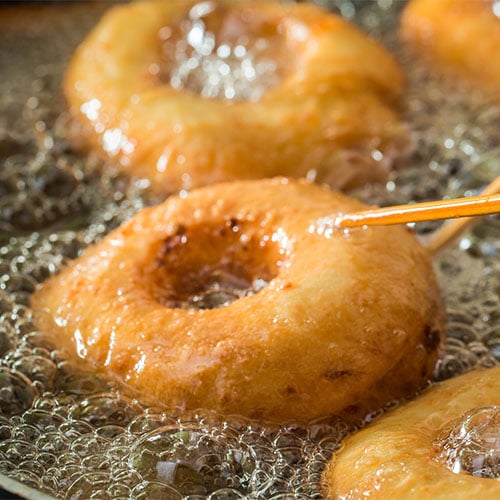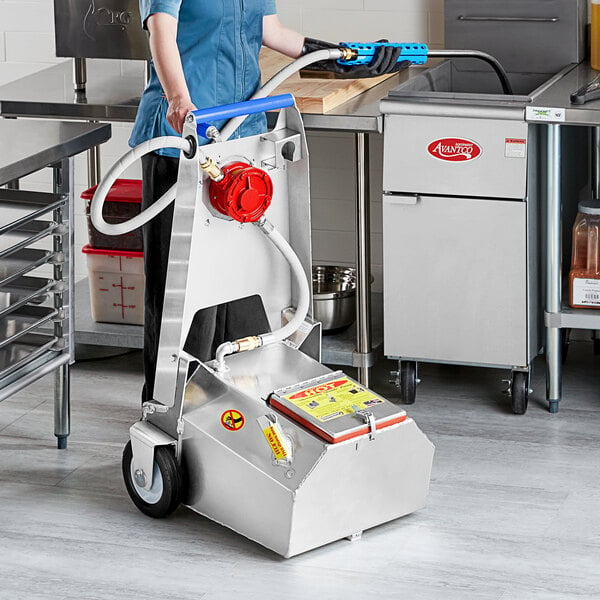Yes, frying oil can be reused. Reusing frying oil can save your establishment money, reduce waste, and maintain food quality, but only if done correctly. Poorly managed oil degrades quickly, leading to bad flavors, inconsistent frying performance, and food safety risks. Below we cover everything commercial kitchens need to know about extending the life of frying oil, from proper filtration and storage to recognizing when it’s time to replace your oil.
Shop All Cooking Oils and SpraysHow to Reuse Frying Oil

Reusing frying oil is a common practice in commercial kitchens to cut costs and reduce waste, but doing it improperly can ruin food quality and even pose health risks. The key is managing oil degradation by filtering and monitoring it correctly. Follow these steps to safely extend the life of your frying oil while maintaining crisp, high-quality fried foods.
- Cool Oil Completely: Let the oil cool below 100 degrees Fahrenheit before handling to avoid burns and ensure safe filtration.
- Strain Through a Fine Mesh or Oil Filter: Remove food particles and debris to prevent off-flavors and fast breakdown.
- Use a Commercial Oil Filtration System (Optional): For high-volume kitchens, automated filters improve efficiency and oil longevity.
- Add Oil Clarifiers: Products like powdered gelatin or activated carbon can help clarify overused oil.
- Avoid Water and Soap Contamination: Never introduce moisture or detergent residues, as they accelerate oil breakdown and create safety hazards.
- Monitor Oil Quality Regularly: Check for darkening, foaming, rancid smells, or excessive smoke before reuse.
Is Reusing Oil Bad?
Reusing oil isn’t inherently bad, but neglecting proper maintenance is. Oil breaks down each time it’s heated, accumulating free fatty acids (FFAs) and polar compounds that affect flavor, texture, and safety. If oil smells rancid, smokes excessively, or foams persistently, it’s time to discard it. Proper filtration and storage help minimize harmful buildup, making reuse safe and cost-effective.
How Many Times Can You Reuse Frying Oil?
Most restaurants reuse frying oil 3–5 times, but this depends on:
- Type of Oil: High-stability oils like peanut or canola last longer than oils with a lower smoke point.
- Foods Being Fried: Breaded items and proteins leave more residue, degrading oil faster than other foods like plain potatoes.
- Filtration and Storage Practices: Well-maintained oil can sometimes last up to 5–7 uses in optimal storage and filtration conditions. As a simple rule, if oil darkens significantly or smokes below frying temperature replace it immediately.
How to Store Used Frying Oil

Proper storage is critical for maintaining the quality and safety of used frying oil in a commercial kitchen. When stored incorrectly, oil degrades rapidly, develops unpleasant flavors, becomes rancid, and even poses fire hazards. Below we've listed the best practices you can use to extend the life of your oil and guarantee consistent frying results:
- Cool Completely Before Storing: Allow oil to cool to room temperature to prevent condensation and bacterial growth in storage containers.
- Filter Thoroughly: Remove all food particles using a fine mesh strainer, cheesecloth, or commercial oil filter to prevent spoilage.
- Use Airtight, Food-Grade Containers: Store in stainless steel or plastic food storage containers with tight-sealing lids to block light and air exposure.
- Keep in a Cool, Dark Place: Store away from heat sources, sunlight, and fryers to slow oxidation.
- Label with Date and Use Count: Track how many times the oil has been used and when it was stored to monitor freshness.
- Never Mix Old and New Oil: Combining used and fresh oil accelerates the degradation of the entire batch.
How Long Can You Keep Used Frying Oil?
Used frying oil can be stored for 1–2 months under ideal conditions, but its shelf life depends on storage conditions. Oil lasts longer in a cool, dark environment versus when it is stored near a heat source. Some other factors that affect the storage life of frying oil include the filtration levels and the type of oil being stored. Well-filtered oil with minimal food residue stays usable longer, and high-stability oils (like peanut or high-oleic sunflower) last longer than vegetable or soybean oil.
How to Dispose of Frying Oil

Properly disposing of used frying oil is just as important as how you use and store it. Pouring oil down drains can cause costly plumbing issues, environmental harm, and even legal violations. Following the correct disposal methods protects your business, complies with regulations, and supports sustainability efforts.
- Recycle Through a Rendering Service: Many companies specialize in collecting used cooking oil for recycling into biodiesel or animal feed. These services often provide storage containers and scheduled pickups for commercial kitchens.
- Donate to Biofuel Programs: Some municipalities and organizations accept used oil for conversion into renewable energy. Check local recycling programs or biofuel co-ops for drop-off locations.
- Use a Grease Disposal Bin: If your area has grease collection bins, transfer cooled oil into a sealed container before depositing.
By reusing frying oil wisely and disposing of it responsibly, you protect your bottom line, maintain food quality, and contribute to a more sustainable foodservice industry. Every step, from filtration to recycling, impacts your kitchen’s efficiency and environmental footprint. Whether extending oil life through careful maintenance or partnering with biofuel programs, these practices ensure you get the most value while meeting regulatory standards. Implement these strategies consistently, and you’ll not only reduce waste but also serve better-tasting fried foods.








